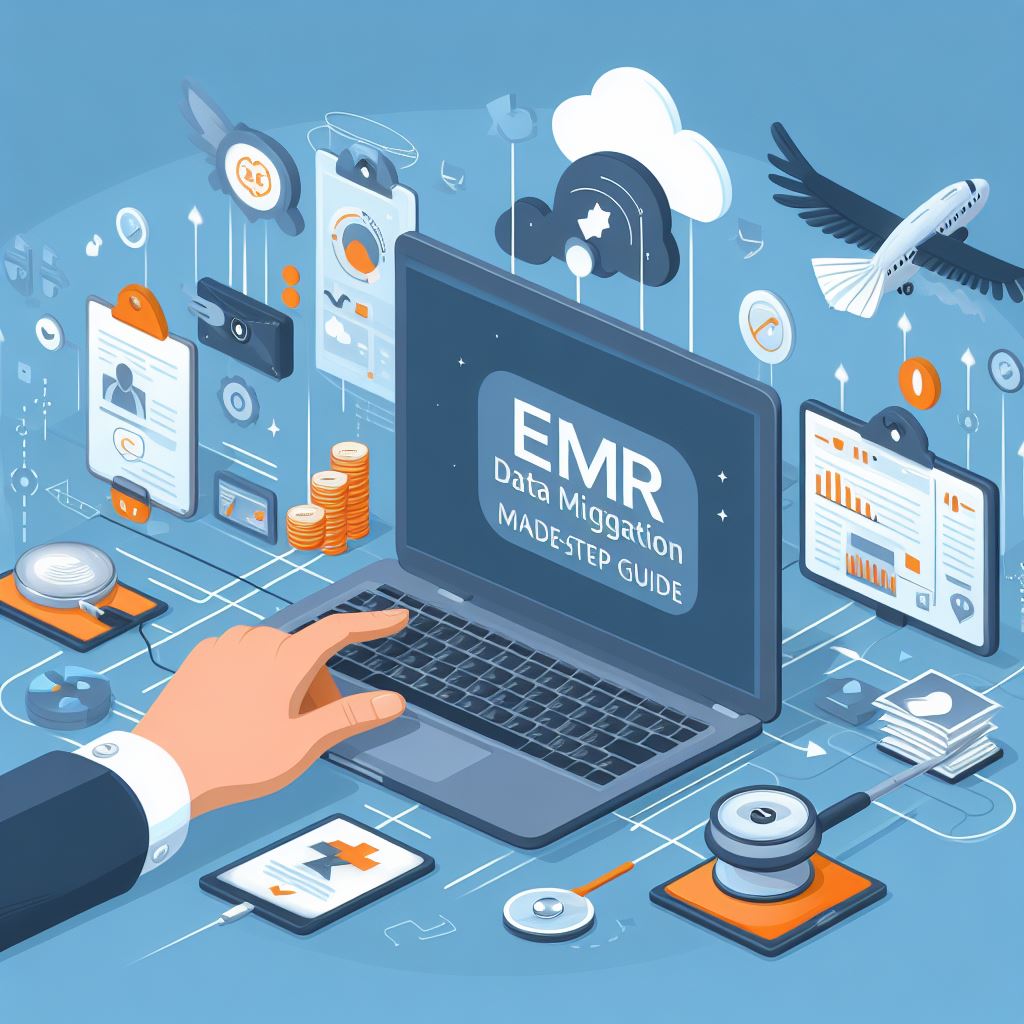Electronic Medical Record (EMR) data migration is a crucial process in healthcare organizations as it involves transferring patient data from one system to another. This can be a daunting task, but with the right approach and tools, it can be simplified and streamlined. In this blog post, we will provide a step-by-step guide on how to migrate your EMR data without any hiccups or complications successfully. From preparing your data for migration to completing the process and ensuring data accuracy, we will cover everything you need to know to make your EMR data migration a success. So, let’s dive in and make EMR data migration easy!
Contents
Assess Your Current EMR System
EMR data migration can be a daunting task for healthcare organizations, but it is a necessary process for ensuring the smooth transfer of patient data to a new system. To make this process easier, it is crucial to follow a step-by-step guide. Firstly, it is important to assess your current EMR system to identify any potential challenges. This will also help in understanding the data structure and format, making it easier to map the data to the new system.
Once you have a clear understanding of your data, it is time to prepare it for migration by cleaning up any duplicate or outdated information and ensuring data integrity. Choosing a reliable migration tool is essential to ensure a successful transfer of data. With various options available in the market, it is crucial to do your research and read reviews before making a decision. Mapping your data is a critical step in the process, as it involves matching the data fields in your current system to the corresponding fields in the new one. Before the final migration, it is recommended to run a test migration to identify any potential issues and address them beforehand.
Scheduling the migration at a time when there is minimal activity in the system can help avoid disruptions or data loss. After the migration is complete, it is crucial to monitor and verify the accuracy of the data in the new system. In conclusion, with proper planning and execution, EMR data migration can be made easy and hassle-free. Remember always to have a backup of your data and seek assistance from experts if needed. By following these steps, you can ensure a smooth and successful transfer of your patient data to the new system.
Prepare Your Data for Migration
EMR data migration is no easy feat. It requires proper planning, organization, and attention to detail to ensure a successful transfer of patient data from one system to another. While it may seem overwhelming, we are here to guide you through the process step by step and make EMR data migration a breeze. First and foremost, it is crucial to assess your current EMR system. This will help you identify any potential challenges and gather important information about your data structure. Next, it’s time to prepare your data for migration.
This involves cleaning up any outdated or duplicate data and ensuring data integrity. Choosing a reliable migration tool is also key. Do your research and seek recommendations from your EMR vendor to find the best fit for your organization. Once you have your tool in hand, it’s time to map your data. Think of it as connecting the dots between your current system and the new one. This step is crucial in ensuring that your data is accurately transferred.
Before the final migration, it is always recommended to run a test migration. This will help you identify any issues or errors that may occur and give you a chance to fix them before the actual process. When it’s time to schedule the migration, make sure to choose a time when your system has minimal activity to avoid any disruptions. After the migration is complete, it is important to monitor and verify the accuracy of your data in the new system. This includes checking for any missing or incorrect data and making necessary corrections. Remember always to have a backup of your data and seek assistance from experts if needed.

Choose a Reliable Migration Tool
Electronic Medical Record (EMR) data migration is a critical process in the healthcare industry, but it doesn’t have to be a daunting task. With the right approach and tools, it can be simplified and streamlined. This process involves transferring patient data from one system to another, which is a crucial step in maintaining accurate and up-to-date records. However, it can also be a complex and time-consuming process if not done correctly. To make EMR data migration easy, it is important to follow a step-by-step guide. The first step is to assess your current EMR system to identify any potential challenges or issues that may arise during the migration process.
Once you have a clear understanding of your system, you can then prepare your data for migration by cleaning up duplicate or outdated information and ensuring data integrity. Choosing a reliable migration tool is also crucial in this process. With so many options available in the market, it is important to do your research and read reviews to find a tool that has a good track record.] Additionally, mapping your data and running a test migration can help identify any errors or issues before the actual process. Scheduling the migration at a time when there is minimal activity in the system is also important to avoid disruptions or data loss.
Once the migration is complete, it is crucial to monitor and verify the accuracy of the data in the new system. This includes checking for any missing or incorrect data and making necessary corrections. In conclusion, EMR data migration can be made easy by following these steps and seeking assistance from experts if needed. It is also important to remember to always have a backup of your data before starting the process. With patience and careful attention, you can ensure a successful and smooth migration of your patient data, making the process a seamless experience for your organization.
Map Your Data
Electronic Medical Record (EMR) data migration is like moving to a new house. You have to carefully pack and organize all your belongings, transport them to the new place, and then unpack and arrange them in their new spots. Just like how you wouldn’t want to lose or damage any of your valuables during a move, the same goes for transferring patient data from one EMR system to another. The process of EMR data migration may seem daunting, but with the right approach and tools, it can be simplified and even made easy. The key is to follow a step-by-step guide that covers all the necessary aspects of a successful migration.
Let’s take a closer look at the steps that can make EMR data migration a smooth and efficient process. First and foremost, it is crucial to assess your current EMR system before beginning the migration process. This will help you identify any potential challenges or issues that may arise during the transfer of data. It is also important to gather information about the data structure and format of your current system, as this will help map the data to the new system.
Next, it’s time to prepare your data for migration. This involves cleaning up any duplicate or outdated data, ensuring data integrity, and organizing the data in a way that makes it easy to transfer to the new system. Think of it as decluttering and organizing your belongings before a big move. Choosing a reliable migration tool is also essential. With so many options available in the market, it is important to do your research and read reviews before making a decision. You can also consult with your EMR vendor for recommendations.
Mapping your data is a critical step in ensuring that your information is transferred accurately and correctly. This involves matching the data fields in your current system to the corresponding fields in the new system. It’s like making sure your furniture fits through the door before moving it into the new house.
Run a Test Migration
EMR data migration may seem like a daunting task, but with the right approach and tools, it can be simplified and streamlined. The first step in this process is assessing your current EMR system to identify any potential challenges. Next, prepare your data by cleaning up any duplicate or outdated information and ensuring data integrity. Choosing a reliable migration tool is crucial, and mapping your data accurately is a critical step to ensure a successful transfer. A test migration should always be conducted before the final migration to address any issues. Scheduling the migration at a time with minimal system activity is important to avoid disruptions.
After the migration, it is crucial to monitor and verify the accuracy of your data in the new system. With these steps, you can make EMR data migration a smooth and hassle-free experience, ensuring your patient data is transferred accurately and securely. Remember to have a backup of your data and seek expert assistance if needed. With patience and careful attention, you can simplify the complex process of EMR data migration and make it a success for your organization.
Schedule the Migration
EMR data migration can be compared to moving to a new house – it’s a daunting task that requires careful planning and organization. Just like how you would pack and label your belongings before moving, preparing your EMR data for migration is crucial. This includes cleaning up any duplicate or outdated data and ensuring data integrity. Choosing a reliable migration tool is also key in ensuring a smooth process. Think of it as hiring professional movers to transport your belongings to your new house safely. Mapping your data is like creating a floor plan for your new house – you want to make sure everything is in the right place.
This step is crucial in ensuring that your data is transferred accurately and correctly. And just like how you would do a walkthrough of your new house before moving in, a test migration is essential to identify any issues that may arise and address them beforehand. Scheduling the migration at a time when there is minimal activity in your system is important to avoid any disruptions. Once the migration is complete, it’s time to unpack and verify the accuracy of your data in the new system. This step is crucial in ensuring that your data is complete and error-free.
Just like how you would arrange your furniture in your new house, verifying your data accuracy is like ensuring everything is in its rightful place. In conclusion, EMR data migration may seem like a daunting process, but with proper planning and execution, it can be made easy. Remember always to have a backup of your data and seek assistance from experts if needed. By following these steps, you can ensure a successful and seamless migration of your patient data, making the transition to a new EMR system a smooth and hassle-free experience.

Monitor and Verify Data Accuracy
EMR data migration may seem like a daunting task, but with the right approach and tools, it can be a surprisingly smooth and easy process. Think of it as a makeover for your patient data – it may take some time and effort, but the result will be worth it. The first step is to assess your current EMR system and gather information about its data structure and format. This will help you identify any potential challenges and prepare your data for migration. Just like decluttering your closet before a big move, cleaning up your data will make the migration process much smoother. Choosing a reliable migration tool is crucial.
Do your research and read reviews before making a decision. Think of it as hiring a moving company – you want to make sure they have a good track record and will handle your data with care. Mapping your data is like creating a blueprint for your new system. This involves matching the data fields in your current system to the corresponding fields in the new system. Double-checking your mappings will ensure that your data is transferred accurately and correctly. Before the final migration, it’s always a good idea to run a test migration.
This will help identify any issues or errors that may occur and give you a chance to address them before the actual process. Scheduling the migration during a time of minimal activity in your system will help avoid any disruptions or data loss. Once the migration is complete, it’s crucial to monitor and verify the accuracy of your data in the new system. Just like checking your new home for any damages after a move, checking for missing or incorrect data is important to ensure a smooth transition. With these steps, you can make EMR data migration a seamless experience for your organization. Remember to have a backup of your data and seek assistance from experts if needed.
Frequently Asked Questions [FAQs]
What is the purpose of EMR data migration?
The purpose of EMR data migration is to transfer patient data from one system to another in a healthcare organization.
Why is it important to assess your current EMR system before migration?
Assessing your current EMR system helps to identify potential challenges and gather information about the data structure and format, making the migration process smoother.
How can data be prepared for EMR data migration?
Data can be prepared for EMR data migration by cleaning up duplicates and outdated data, ensuring data integrity, and organizing it in a way that is transferable to the new system.
What is the role of mapping in EMR data migration?
Mapping is the process of matching data fields from the current system to the corresponding fields in the new system. It ensures that data is transferred accurately and correctly.
Conclusion
EMR data migration doesn’t have to be a headache. With our step-by-step guide, you’ll be able to transfer patient data without any hiccups or headaches seamlessly. From assessing your current system to verifying data accuracy, we’ve got you covered. So, let’s make EMR data migration easy and stress-free together!





